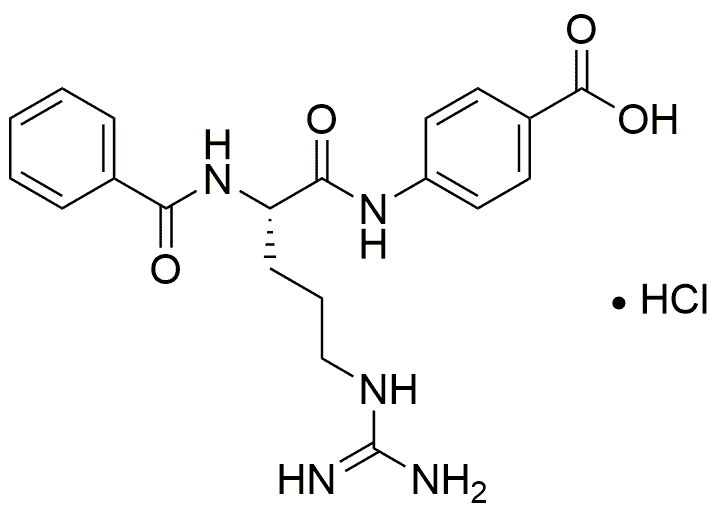Bz-Arg-4-Abz-OH·HCl is widely utilized in research focused on:
- Peptide Synthesis: This compound serves as a key building block in the synthesis of peptides, particularly in the development of therapeutic agents. Its unique structure enhances the stability and efficacy of peptide drugs.
- Drug Delivery Systems: It is employed in formulating drug delivery systems that improve the bioavailability of poorly soluble drugs, making treatments more effective and accessible for patients.
- Bioconjugation: The compound is used in bioconjugation processes, allowing researchers to attach biomolecules to drugs or imaging agents, facilitating targeted therapies in cancer treatment.
- Research in Neuroscience: Bz-Arg-4-Abz-OH·HCl is applied in studies related to neurotransmitter function, aiding in the development of novel treatments for neurological disorders.
- Diagnostics: This chemical plays a role in the development of diagnostic tools, particularly in assays that require high specificity and sensitivity, improving disease detection methods.
General Information
Properties
Safety and Regulations
Applications
Bz-Arg-4-Abz-OH·HCl is widely utilized in research focused on:
- Peptide Synthesis: This compound serves as a key building block in the synthesis of peptides, particularly in the development of therapeutic agents. Its unique structure enhances the stability and efficacy of peptide drugs.
- Drug Delivery Systems: It is employed in formulating drug delivery systems that improve the bioavailability of poorly soluble drugs, making treatments more effective and accessible for patients.
- Bioconjugation: The compound is used in bioconjugation processes, allowing researchers to attach biomolecules to drugs or imaging agents, facilitating targeted therapies in cancer treatment.
- Research in Neuroscience: Bz-Arg-4-Abz-OH·HCl is applied in studies related to neurotransmitter function, aiding in the development of novel treatments for neurological disorders.
- Diagnostics: This chemical plays a role in the development of diagnostic tools, particularly in assays that require high specificity and sensitivity, improving disease detection methods.
Documents
Safety Data Sheets (SDS)
The SDS provides comprehensive safety information on handling, storage, and disposal of the product.
Product Specification (PS)
The PS provides a comprehensive breakdown of the product’s properties, including chemical composition, physical state, purity, and storage requirements. It also details acceptable quality ranges and the product's intended applications.
Certificates of Analysis (COA)
Search for Certificates of Analysis (COA) by entering the products Lot Number. Lot and Batch Numbers can be found on a product’s label following the words ‘Lot’ or ‘Batch’.
Número de catálogo
Número de lote/lote
Certificates Of Origin (COO)
This COO confirms the country where the product was manufactured, and also details the materials and components used in it and whether it is derived from natural, synthetic, or other specific sources. This certificate may be required for customs, trade, and regulatory compliance.
Número de catálogo
Número de lote/lote
Safety Data Sheets (SDS)
The SDS provides comprehensive safety information on handling, storage, and disposal of the product.
DownloadProduct Specification (PS)
The PS provides a comprehensive breakdown of the product’s properties, including chemical composition, physical state, purity, and storage requirements. It also details acceptable quality ranges and the product's intended applications.
DownloadCertificates of Analysis (COA)
Search for Certificates of Analysis (COA) by entering the products Lot Number. Lot and Batch Numbers can be found on a product’s label following the words ‘Lot’ or ‘Batch’.
Número de catálogo
Número de lote/lote
Certificates Of Origin (COO)
This COO confirms the country where the product was manufactured, and also details the materials and components used in it and whether it is derived from natural, synthetic, or other specific sources. This certificate may be required for customs, trade, and regulatory compliance.


